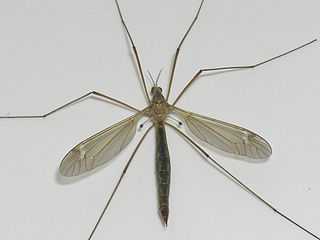Halteres
Halteres (/hælˈtɪəriːz/; singular halter or haltere) are small knobbed structures modified from a pair of wings in some two-winged insects. They are flapped rapidly and function as gyroscopes, informing the insect about rotation of the body during flight.[1] The word 'halter' comes from Greek ἁλτήρ, Halteres, a double knobbed device used in Ancient Greece by athletes during training in jumping.
The halteres evolved from insect wings. The ancestral insect species had two pairs of wings (like dragonflies and most other flying insect species have). In the Strepsiptera (small insects parasitic on bees, wasps and cockroaches) the forewings evolved into halteres, while in the Diptera (flies, mosquitoes and gnats) the hindwings changed into halteres.
In Diptera, the formation of the haltere during metamorphosis is dependent on the homeotic gene Ultrabithorax (Ubx). If this gene is experimentally deactivated, the haltere will develop into a fully developed wing.[1] This is an excellent illustration of an important mechanism of evolutionary development: a simple homeotic gene change resulting in a radically different phenotype.
Halteres flap up and down as the wings do and operate as vibrating structure gyroscopes. Every vibrating object tends to maintain its plane of vibration if its support is rotated, a result of Newton's first law. If the body of the insect changes direction in flight or rotates about its axis, the vibrating halteres thus exert a force on the body, which can be viewed as the Coriolis effect in action. The insect detects this force with sensory organs known as campaniform sensilla located at the base of the halteres. The planes of vibration of the two halteres are orthogonal to each other, each forming an angle of about 45 degrees with the axis of the insect; this increases the amount of information gained from the halteres.
Halteres thus act as a balancing and guidance system, helping these insects to perform their fast aerobatics. In addition to providing rapid feedback to the muscles steering the wings, they also play an important role in stabilizing the head during flight.
References
External links
- QED: These tiny flying machines really are magnificent, The Telegraph, 9 February 2005
- Photo of a haltere of a mosquito (Nematocera)
